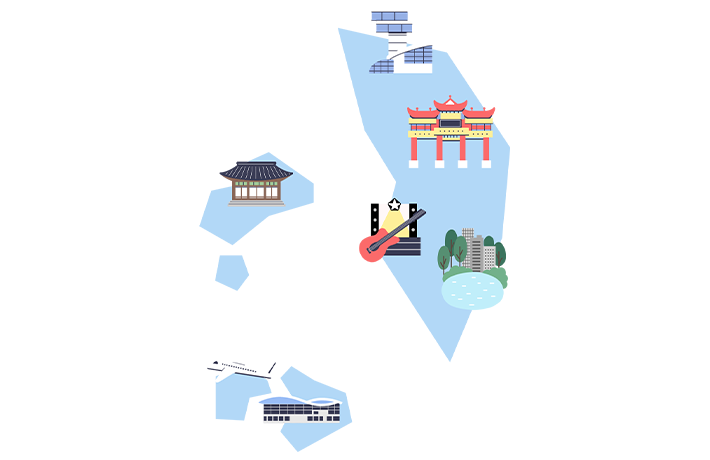

GYEONGGI

Gyeonggi-do
Gyeonggi Province encompasses all aspects of culture, arts, and leisure. Located near Seoul, it offers good accessibility and a variety of cultural activities, making it ideal for weekend outings. Cities like Paju and Yeoju, known for their outlets, are cultural hubs with plenty to see, while Yangpyeong and Gapyeong are perfect for those who want to enjoy a leisurely day amidst nature.
moreSEOUL

Seoul
Traveling through Seoul, where the past and present coexist and change daily, makes every visit feel new. The city is home to beautiful palaces that retain their 600-year history right in the heart of the metropolis, as well as vibrant arts and culture districts leading trends in South Korea. Seoul is an ideal destination for urban exploration.
moreINCHEON

Incheon
Incheon, with its slightly briny sea scent, is charmingly unique. It effectively utilizes its geographical features to develop both inland and coastal tourism. Notable maritime attractions include Eulwangri Beach and the cultural district of Wolmido, and Incheon’s Chinatown is also a popular destination. Additionally, the city has various historical artifacts scattered throughout, making it a great place for a history-themed tour.
moreGANGWON

Gangwon State
Gangwon Province is renowned for its outstanding natural scenery. Depending on the season, you can enjoy a range of outdoor sports such as rafting, paragliding, riding, and skiing. Donghae’s Jeongdongjin, a renowned sunrise spot, and Nami Island, accessible by boat and famous for its picturesque Metasequoia Road, are excellent for romantic dates. Cycling around Chuncheon’s lakes is also a recommended leisurely activity.
moreCHUNGBUK

Chungcheongbuk-do
Chungcheongbuk-do is a great destination for nature lovers. In Danyang, a top travel spot in the province, paragliding over the Chungju Lake is popular. The sunset views at Dodamsambong are beautiful, and Jecheon, with its oldest reservoir, Uirimji, is well-known among photographers. Hiking the historic trails of the Seongnam Old Road in Goesan County, which features Korea’s best hiking trails, is also recommended.
moreCHUNGNAM

Chungcheongnam-do
Chungcheongnam-do retains the legacy of Baekje. With historical sites such as the Baekje capitals of Gongju and Buyeo, the area is rich in temples and cultural heritage. At Dangjin’s Waemok Village, you can view the sunrise over the West Sea, while Boryeong offers the unique experience of the Mud Festival, where you can play in mud with visitors from around the world.
moreJEONBUK

Jeollabuk-do
Jeollabuk-do preserves the original forms of Korean culture. Jeonju, with its traditional hanok village in the city center, is a key tourist destination. Sampling Jeonju's famous bibimbap and experiencing the hanok village in traditional attire are must-dos. You can also explore Namwon’s Gwanghallu, where the love story of Chunhyang and Mong-ryong began, and travel through the modern architecture of Gunnersan and Iksan from the Japanese colonial era.
moreJEONNAM

Jeollanam-do
Jeollanam-do, known for its rich traditions and unique regional characteristics, includes destinations like Damyang with its impressive bamboo forests, Boseong with its lush green tea fields, and the scenic Yeosu night sea. For a golden view of the reed fields, visit the Suncheon Bay Reed Festival in early November. Enjoy the diverse natural attractions of Jeollanam-do, from marine to mountain tourism.
moreGYEONGBUK

Gyeongsangbuk-do
Gyeongsangbuk-do is a representative area for Korean cultural development. Starting from Gyeongju, known as the thousand-year-old capital of Silla, to Andong’s Hahoe Village, a UNESCO World Heritage site, the province is ideal for exploring long-standing traditions and historical sites. You can also visit the scenic Ulleungdo and Dokdo, which are often difficult to reach due to weather conditions but offer stunning natural beauty.
moreGYEONGNAM

Gyeongsangnam-do
Gyeongsangnam-do offers both mountain and marine tourism experiences. The maritime parks centered around Tongyeong and Namhae allow you to enjoy both islands and sea. In spring, you can visit the Hwagae Cherry Blossom Festival and the Sunmae-won Plum Blossom Festival, while winter brings the Dongbaek Festival that colors Geoje Island red. Additionally, you can enjoy various experiences such as hot springs, pottery making, and strawberry picking.
moreDAEGU

Daegu
Daegu is known for being the hottest city in Korea. However, the annual Chimac Festival (a combination of chicken and beer) makes the heat more bearable. E-World amusement park is great for family outings, and Duryu Park is ideal for walks. The music fountain show at Suseong Lake and the uniquely designed exhibition space, Daegu Art Museum, are highlights of Daegu’s nightscape. The Seomun Market, one of Korea’s top three markets, is a must-visit hot spot.
moreBUSAN

Busan
Busan, Korea’s second-largest city, offers vibrant attractions such as Haeundae Beach, which becomes even more dazzling with the night view of Marine City. Gamcheon Culture Village is perfect for photography, and the Busan International Film Festival, Asia’s largest film festival held every autumn, adds to the city's charm. Busan’s food scene, with its traditional market tours, is also essential for a complete experience.
moreJEJU

Jeju Island
Jeju Island is a massive tourist resource in itself. The emerald waters of Hyeopjae Beach are a top destination, while the Jeju Jusangjeolli Cliffs and Yongmeori Coast offer unique natural landscapes. The popular filming location Seopjikoji continues to attract visitors, and Jeju’s local foods such as Hallabong oranges, black pork, and silver cutlassfish are highly recommended.
more









